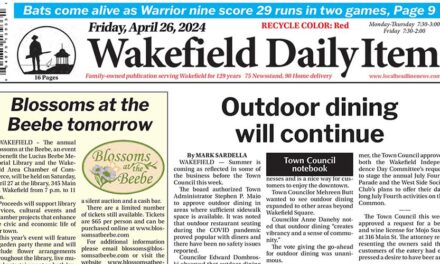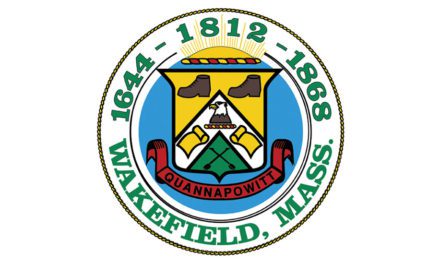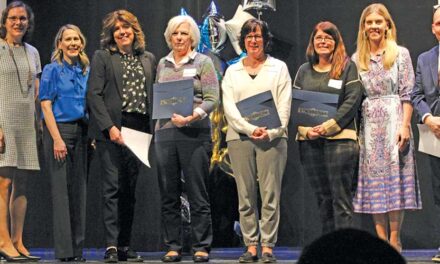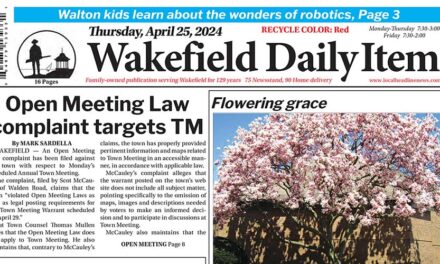Published in the April 12, 2016 edition.
By MARK SARDELLA
WAKEFIELD — A recently completed town-wide drainage study has identified nearly $54 million worth of improvements that the town could make to its drainage system.
The consultants from Wright-Pierce Engineering that performed the study came before the Board of Selectmen last night to provide an overview of their findings. They recognized that addressing everything at once was not financially realistic but said if the town were to “start to pick away” at addressing the areas of concerns it would “provide some benefit.”
Public Works Director Richard Stinson introduced the team from Wright-Pierce which included Peter Atherton, Ryan Wingard and Paul Brinkman. Brinkman walked the board through a PowerPoint presentation highlighting the study’s findings.
He noted that the town had been “doing an excellent job in maintaining” the status quo as it relates to drainage in the town.
But he said that development throughout the region has changed the drainage system’s ability to manage storm water and increased the likelihood of flooding. He said that increases in the impervious surface area of Wakefield and surrounding communities have impacted Wakefield to a greater degree than it has other communities. Wakefield’s impervious cover, Brinkman said was 30 percent as compared to Lynnfield (15 percent), Reading (20 percent) and Saugus (27 percent).
Brinkman attributed another part of the drainage problem to climate change, which he maintained had resulted in “more intense storms” in recent years.
He said that the town had identified 16 problem areas in the town and part of the work of the study was to confirm if indeed those areas were problems. The consultants created a computerized hydraulic model to look at problem areas and identify possible improvements.
Brinkman cited Ware Street as an example of one problem area that had serious flooding issues. He said that several alternatives were looked at for mitigating the issues on Ware Street.
One alternative was to increase the drainage pipe size but that would cause downstream flooding. Another alternative was to increase water storage areas but it was determined that the water volumes were too large for that to be effective.
Finally, they determined in the Ware Street example that that the best alternatives were flood proofing measures such as walls, berms and dikes.
Another finding of the drainage study was that sediment buildup causes increased flooding as its makes streams narrower and more shallow.
Brinkman commended Stinson and the DPW for using as little sand as possible when treating the roads in the winter as much of the sand can makes its way into the drainage system and contributes to sediment buildup. He also lauded the DPW for being diligent when it comes to street sweeping to prevent some of the sand and debris on the roadways from entering the drainage system.
He also said that the town had done a good job with catch basin cleaning and yard waste management. He said that making it as easy as possible for residents to properly dispose of leaves and other yard waste cuts down of the amount of that material getting into the drainage system and causing problems.
Brinkman also cited the town’s use of Eastern Middlesex Mosquito Control. One of the things they do, he explained, was to go through streams and remove debris that can cause pooling.
He said that the consulting team wanted to create a “balanced, prioritized plan” that would not create problems for other towns or make improvements in one area at the expense of another.
Along with the $54 million capital improvement plan, Brinkman identified a number of recommendations that the town could do immediately at low cost.
The town could optimize its street-sweeping program, fine tune its catch basin cleaning program, increase its pipeline-cleaning and inspection program, improve swale and stream maintenance and employ a dedicated staff person to deal with storm water issues. Another possibility mentioned was charging residents and businesses a storm water utility fee to help pay for some of the improvements to the drainage system.
Selectman Betsy Sheeran pointed out that the recommended improvements would not happen overnight. She also hoped that other towns would reciprocate the consideration that the Wakefield drainage plan shows for their communities.
Selectman Paul DiNocco, who lives on Wiley Street, said that the measures outlined in the study would not do anything to alleviate the flooding in his area of town.
But Stinson said that a new DPW position that was added to next year’s budget to deal with storm water issues and drainage would help to address that problem. Brinkman added that restoring the Mill River to its original depth and length would help to allow the water to flow better in the area of Water Street near the Saugus line.
Selectman Brian Falvey asked if it was up to the selectmen to take a leadership role in getting the ball rolling on the recommended improvements. He also suggested that the standard for developers should not be that they simply not make drainage worse. He said that the town should insist that developers actually improve drainage as a condition of building their projects.
Stinson said that his department would be looking for available grants and based on what they find would come back to the selectmen.
Selectman Phyllis Hull asked if the drainage issue was the most pressing problem in town. She said that if millions of dollars to fix drainage was a top priority, then the town might have to take a hard look at whether it makes sense to spend millions on a new high school.
Stinson said that the drainage study was being finalized and would soon be available in the Town Administrator’s office and the DPW office at Town Hall for residents to look at it. He said that it would also be available to permitting boards like the Board of Appeals, the Planning Board and the Conservation Commission.




